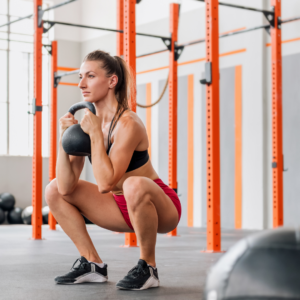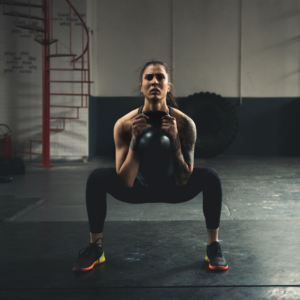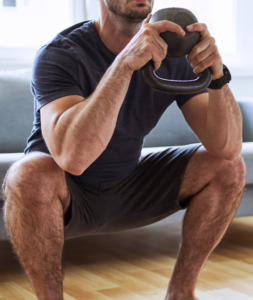Why You Need To Learn The Goblet Squat Now
Part of our ongoing series on the endless sea of squat variations:

Of all the seemingly endless variations of the squat, the goblet squat holds a special place for us.
Squats are a staple exercise in any workout. From bodyweight squats to standard barbell squats, and a seemingly endless list of variations in between, you can find a squat for almost any purpose or setting. The squat is one of the most fundamental and functional exercises, and it can help you towards whatever goals you may have.
Of that list of variations, the goblet squat is easily one of our favorites. It’s a great way to work the muscles of the core, back, forearms, and to a lesser degree, the shoulders and the upper back. And this variation can drastically improve your posture and squat form. It aids in fat loss, particularly in the lower body and midsection. It even goes a long way towards helping prevent injury.
Benefits of Goblet Squats
Increased range of motion
which means increased glute activation
Holding the weight in front of you and at your chest allows you to get lower easier than in a standard barbell squat.
Your center of gravity is shifted, and it becomes more comfortable to sit back on your heels and get low with flat feet. This can also make it easier to balance as you sink lower into the squat.
Range of motion matters if you want your glutes to get in on the work. The lower you can squat with good form, the more the glutes are stretched and engaged. The goblet squat makes this easy and natural.
Increased core activation
Because of the placement of the weight in the goblet squat, the core has to work harder to maintain a neutral spine and good posture.
real-life applications
Goblet squats are a great functional way to strengthen your body for real-world applications. A lot of the ordinary occasions that will call on your strength will be closer to a goblet squat than almost anything else.
Visualize, for example, picking up a child or lifting furniture. We don’t often put something on our back to lift it up. We often hold something close to the front of our body and lift with our legs. And when we don’t lift things this way, bad things often happen to the back.
Across The Board Injury Protection
One major concern with squats is protecting the back from injury.
One of the greatest benefits of the goblet squat is how it helps you improve your squat form, which helps prevent injury. A standard squat often brings out the worst in form errors, with people commonly stuck in make mistakes that can quickly lead to lower back and knee problems.
We can’t emphasize enough how well the goblet squat puts you in a position to keep a straight spine and posture. It also makes it easier to focus on and learn to engage your lats and your core. And it can even fix one of the most common squat mistakes – the oft-mentioned knee valgus, the inward collapse of the knees at the bottom of the squat.
Holding the weight places your elbows in a very specific position, and as you lower yourself, your knees must push outward to allow your elbows to lower. As your elbows touch the insides of your knees at the bottom of the goblet squat, and you drive upwards, you’ll find yourself finally keeping those knees out.
And deeper squats are actually safer for your knees. Studies have shown that lower knee joint stress is experienced in deeper squats. Goblet squats, then, are actually a great way to strengthen your knees.
do it anywhere
You’ll reap the benefits of a weighted squat, but you don’t need a barbell, or a squat rack, or even a gym.
And if you don’t have a kettlebell, you can use a dumbbell, a medicine ball, or improvise with a small, heavy household item.

How to Goblet Squat
-
- Stand with your feet shoulder-width or slightly wider, your toes straight forward or angled slightly outward.
- Hold the weight at your chest, one hand on either side of the handles, elbows pointed downward. Engage your lats (pull your shoulder blades down and back, toward your back pockets). Keep the kettlebell close to your chest throughout.
- Engage your core (brace as if you’re going to take a punch to the gut, but remember to breathe), and keep your eyes forward.
- Move back with your hips and lower yourself into the squat. Inhale on the way down.
- Keep your chest up (show the person in front of you the logo on your shirt) as you continue down, as low as you can while maintaining proper form.
- Keep your feet flat. You should never be on your toes.
- At the bottom, your elbows should be inside your knees. This helps keep your knees aligned over your toes as you go deep squat position.
- Drive through your heels to come back up. Exhale as you come up and engage your glutes at the top.
What to Avoid
forward lean
If you lack core strength ankle flexibility, your torso will be tempted to tilt forward as you squat down.
To counteract this, focus on engaging your lats and core throughout the movement, making sure the dumbbell or kettlebell stays close to your chest. Make sure to move through your hips to lower.
Holding the Weight Too Far From Your Body
The kettlebell should always be kept close to your body at your chest when performing a goblet squat. If it’s not, your biceps, forearms and shoulders will have to do more of the work, just to keep balance.
Your legs drive a squat much more efficiently than your arms, they’re what you’re working here, and shifting the load off of them will just slow your progression.
Rising Up On Your Toes
Since the kettlebell is held in front of your body as you perform the goblet squat, if you have other form problems, they can cause you to come up on your toes as you lower yourself.
Putting weight on the toes is more likely to throw you off balance, endanger your knees, and slow your progress.
Keep your chest and torso upright. This will help keep your center of gravity back and over your heels. Your weight should be evenly distributed across your feet, except your toes, which you should be able to wiggle around throughout the movement.

THE LAST WORD
The goblet squat is a great squat variation that goes far beyond just working your legs. It’s a full-body movement that works all the major muscle groups of the lower body, engaging your core, back, arms, and even shoulders and upper back.
It takes you through a full range of motion while preventing common mistakes. It can be a great progression from bodyweight for beginners or a useful variation for the more experienced.
Whether you’re trying to improve your squat form, get lower in your squat, focus on your glutes, or find a way to mix it up on leg day, the goblet squat is a great variation to incorporate into your program.

